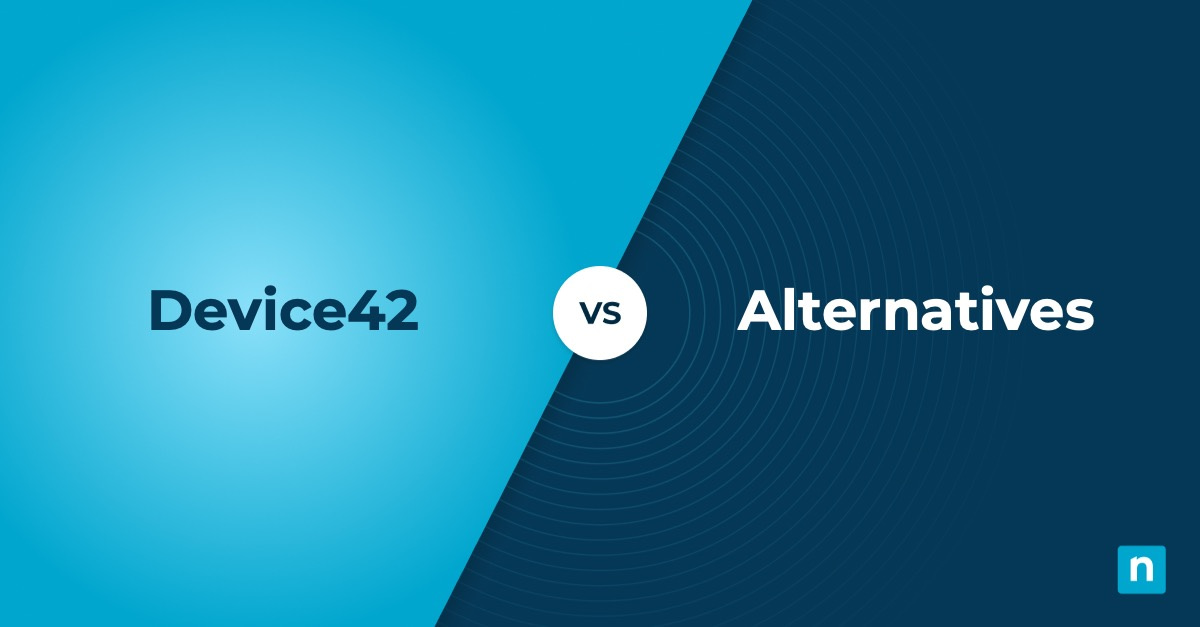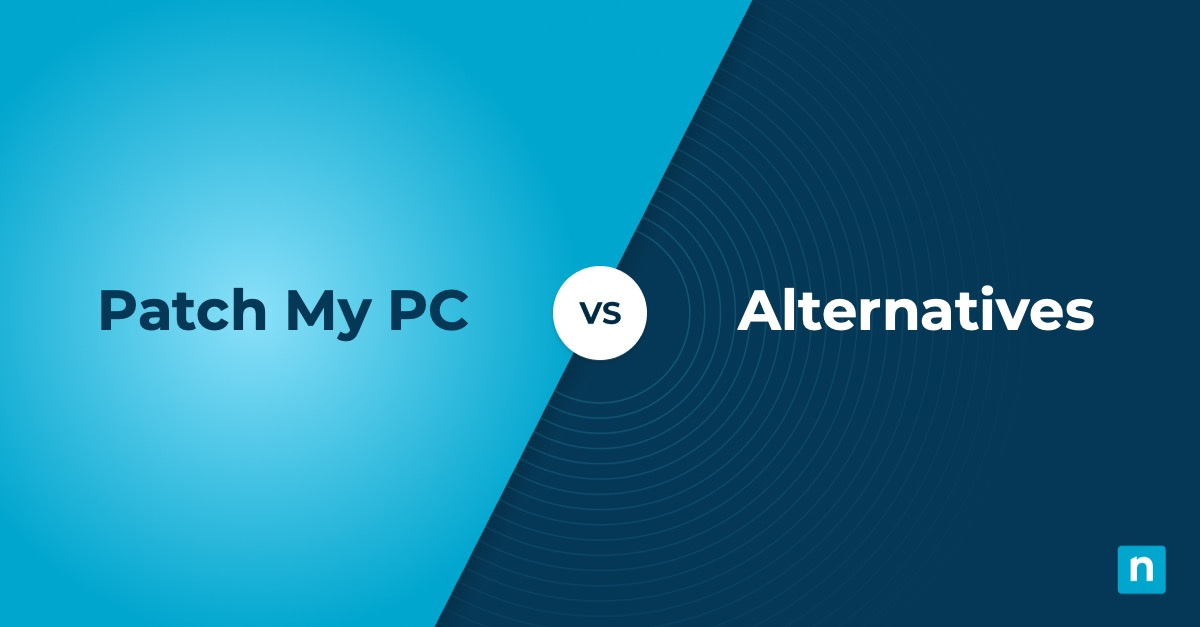With networks becoming increasingly complex each year, it is crucial that you gain proper visibility into all your network components so that you can maintain your competitive advantage. Network documentation includes all the information you and your IT team need to keep your IT network running smoothly and create more impactful stories for all your stakeholders. In fact, the 2024 Uptime Annual Outage Analysis has found that 74% of outages are due to mission-critical infrastructure failures, with networking issues causing a large portion of IT outages.
You must use the right tools to streamline the documentation process. The 2024 State of the CIO report found that 88% of CIOs said that their role is becoming more digital and innovation-focused, prompting them to look for the right software to support their digital transformation initiatives and ensure the smooth functioning of their network.
In this guide, we will explore the best network inventory documentation tools available in the market today.
Discover all the benefits NinjaOne’s IT asset management software or its network management system provides for IT departments and MSPs. Sign up for your free trial today.
What is network inventory documentation?
Network inventory documentation is the process of tracking and recording all devices and IT assets that are connected to a network. An accurate network inventory can provide valuable information to assist with many day-to-day processes, such as troubleshooting, management, IT visualization, budgeting, and more.
Why do you need a network inventory documentation tool?
The benefits of proper network documentation are priceless. Imagine starting a new job and needing to understand the network’s current setup. However, you find out that your new job doesn’t have much documentation or any IT plan that describes the current resources and architecture.
How do you know what to do or improve if you don’t even know where you are? It could take you months (if you’re lucky) to draw up plans and optimize your processes. Those months could have been better spent focusing on more strategic projects. And even then, how do you optimize your documentation processes so the next person hired after you doesn’t have to go through the same tedious cycle?
Network inventory management is crucial here. The right network inventory documentation tool can:
- Save you from performing time-consuming research to detect and resolve recurring problems.
- Troubleshoot network issues much faster.
- Help everyone on your team follow the same processes and procedures to achieve consistency in your IT network.
- Prevent losing valuable information when an employee leaves the company.
- Onboard new employees with more knowledge and efficiency.
How to do network inventory documentation?
To manage your network inventory, you need to have an inventory system set up. A couple of steps that every basic network inventory management system has includes:
1) Set up a network inventory spreadsheet
A network inventory spreadsheet, or list, will give you an idea of what IT assets are currently on your network. You can begin by listing the IT inventory you know is on your network, then searching for additional assets on the network.
2) Find additional network inventory
Large IT infrastructures require active and passive tools to find and identify all the inventory on a network. Active tools automatically scan a network for new inventory while passive tools monitor the current inventory.
3) Update your network inventory
Your network inventory is always changing. New devices, software, hardware, and other changes to IT assets on the network should be reflected in your network inventory spreadsheet.
As you can see, managing network inventory takes time, especially if you have a large IT infrastructure. Although smaller businesses might get away with using a single spreadsheet for network inventory documentation, medium to large businesses and MSPs require a more efficient and scalable system. Fortunately, there are plenty of network inventory documentation tools that streamline the process, making it quicker and easier.
How to choose your network inventory documentation tool
The two types of tools that are used for network inventory documentation are network monitoring and management tools and IT documentation tools. You can use these tools separately or in unison to gain insight into your network inventory.
While IT documentation tools are static views of imputed information, network monitoring and management tools provide a live view of a network. This live view allows users to see the current network inventory at any time.
Before choosing a network inventory documentation tool, consider how each will benefit your department. If you require a live view of your network, a network monitoring and management tool, such as NinjaOne’s IT asset management software and network management software, is a great option. If your department uses static documentation to manage network inventory, then an IT documentation tool could be the better choice.
Table of Contents
-
NinjaOne
-
Auvik
-
IT Glue
-
Progress WhatsUp Gold
-
Datadog
-
ManageEngine OpManager
-
Lansweeper
-
PRTG
-
Zabbix
-
SolarWinds Network Performance Monitor
10 Best Network Inventory Documentation Tools
All G2 & Capterra scores were taken on May 2024.
1. NinjaOne (⭐️⭐️⭐️⭐️⭐️ 1,191 reviews)
NinjaOne offers powerful IT asset management software that helps you gain complete, accurate, and real-time insight into all your managed IT assets, including Windows servers, workstations, and laptops; macOS workstations and laptops; Linux servers, workstations, and laptops; VMWare and Hyper-V hosts and guests; and SNMP devices (firewalls, switches, routers, etc.). Its platform is ideal for IT enterprises that need live asset data to make a quick decision.
Some of its key features include:
- Automated IT asset discovery and management using Microsoft Active Directory.
- Proactive strategies on real-time IT asset information so you can make more informed decisions about your IT network.
- Easily find, group, and manage assets so you can apply policies to them.
- Track and be alerted on any asset changes.
- Monitor and manage software at scale.
NinjaOne’s software follows all your IT assets through the state of lifecycle management, from requisition to retirement. This ensures that all your endpoints, devices, and non-physical assets are accounted for and maintained at all times.
NinjaOne’s IT management software has no forced commitments and no hidden fees. If you’re ready, request a free quote, sign up for a 14-day free trial, or watch a demo.
NinjaOne reviews on G2
| Category | NinjaOne Rating |
| Overall | 4.8 out of 5 (1,191) |
| Has the product been a good partner in doing business? | 9.6 |
| Quality of support | 9.5 |
| Ease of Admin | 9.3 |
| Ease of Use | 9.3 |
Number of 2024 G2 awards: 9
NinjaOne reviews on Capterra
| Category | NinjaOne Rating |
| Overall | 4.8 out of 5 (211) |
| Ease of Use | 4.8 |
| Customer Service | 4.8 |
| Features | 4.6 |
| Value for Money | 4.7 |
| Likelihood to Recommend | 94% |
2. Auvik (4.5 312 reviews)
Auvik is cloud-based network management software that provides automated network discovery, documentation, and monitoring in an easy-to-use dashboard. All actions are performed on a single dashboard so that you can perform multiple actions much more easily.. Aside from proactive alerting, it also offers troubleshooting through a centralized Syslog and backup options.
See how Auvik compares with NinjaOne or read a more in-depth analysis of Auvik competitors.
Auvik reviews on G2
| Category | Auvik Rating |
| Overall | 4.5 out of 5 (312) |
| Has the product been a good partner in doing business? | 9.1 |
| Quality of support | 8.9 |
| Ease of Admin | 8.7 |
| Ease of Use | 8.7 |
Number of 2024 G2 awards: 0
Auvik reviews on Capterra
| Category | Auvik Rating |
| Overall | 4.7 out of 5 (72) |
| Ease of Use | 4.4 |
| Customer Service | 4.6 |
| Features | 4.5 |
| Value for Money | 4.3 |
| Likelihood to Recommend | 88% |
3. IT Glue (4.6 410 reviews)
IT Glue is a cloud-based IT documentation software that helps you easily track, find, and gain insights into your IT network. Its SOC 2-compliant platform offers a specific add-on, Network Glue, an all-in-one automated discovery, documentation, password rotation, and diagramming solution for IT enterprises looking for a reliable network inventory documentation tool.
IT Glue reviews on G2
| Category | IT Glue Rating |
| Overall | 4.6 out of 5 (423) |
| Has the product been a good partner in doing business? | 8.9 |
| Quality of support | 8.7 |
| Ease of Admin | 8.9 |
| Ease of Use | 9.1 |
Number of 2024 G2 awards: 0
IT Glue reviews on Capterra
| Category | IT Glue Rating |
| Overall | 4.7 out of 5 (243) |
| Ease of Use | 4.5 |
| Customer Service | 4.5 |
| Features | 4.5 |
| Value for Money | 4.5 |
| Likelihood to Recommend | 87% |
4. Progress WhatsUp Gold (4.5 303 reviews)
WhatsUp Gold is an IT infrastructure monitoring software that enables you to monitor your IT network’s up/down status, availability, and performance in a single console. Its platform provides complete visibility into everything that is connected to your network, including devices, servers, and virtual machines, so that you can diagnose issues faster and with more accuracy.
Progress WhatsUp Gold reviews on G2
| Category | Progress WhatsUp Gold Rating |
| Overall | 4.5 out of 5 (303) |
| Has the product been a good partner in doing business? | 9.0 |
| Quality of support | 8.8 |
| Ease of Admin | 8.2 |
| Ease of Use | 8.5 |
Number of 2024 G2 awards: 0
Progress WhatsUp Gold reviews on Capterra
| Category | Progress WhatsUp Gold Rating |
| Overall | 4.5 out of 5 (222) |
| Ease of Use | 4.2 |
| Customer Service | 4.5 |
| Features | 4.4 |
| Value for Money | 4.3 |
| Likelihood to Recommend | 84% |
5. Datadog (4.3 468 reviews)
Datadog is a cloud-based monitoring and analytics platform that provides real-time insights into your IT environment. The platform provides metrics, visualizations, and alerting into your cloud or hybrid environments so that you can troubleshoot more effectively.
Datadog reviews on G2
| Category | Datadog Rating |
| Overall | 4.3 out of 5 (468) |
| Has the product been a good partner in doing business? | 8.5 |
| Quality of support | 8.83 |
| Ease of Admin | 8.4 |
| Ease of Use | 8.2 |
Number of 2024 G2 awards: 0
Datadog reviews on Capterra
| Category | Datadog Rating |
| Overall | 4.6 out of 5 (242) |
| Ease of Use | 4.3 |
| Customer Service | 4.3 |
| Features | 4.5 |
| Value for Money | 4.1 |
| Likelihood to Recommend | 82% |
6. ManageEngine OpManager (4.5 82 reviews)
ManageEngine OpManager is a network monitoring solution for devices such as routers, switches, firewalls, wireless LAN controllers, and servers. It is designed to help companies of all sizes anticipate potential outages and proactively address network issues. Specifically, OpManager monitors the performance of any IP-based device and helps businesses remotely visualize their system performance.
ManageEngine OpManager reviews on G2
| Category | ManageEngine OpManager Rating |
| Overall | 4.5 out of 5 (83) |
| Has the product been a good partner in doing business? | 9.1 |
| Quality of support | 8.7 |
| Ease of Admin | 9.1 |
| Ease of Use | 8.8 |
Number of 2024 G2 awards: 9
ManageEngine OpManager reviews on Capterra
| Category | ManageEngine OpManager Rating |
| Overall | 4.7 out of 5 (93) |
| Ease of Use | 4.5 |
| Customer Service | 4.6 |
| Features | 4.5 |
| Value for Money | 4.6 |
| Likelihood to Recommend | 90% |
7. Lansweeper (4.4 56 reviews)
Lansweeper provides complete visibility into your IT, OT, and IoT assets. This all-in-one solution helps you discover, manage, and optimize all your technology assets to improve efficiency, detect rogue devices, vulnerabilities, and compliance issues, and reveal needless expenses. Lansweeper leverages automation for its asset discovery and inventory processes so that you gain complete control over your IT estate.
See how Lansweeper compares with NinjaOne or read a more in-depth analysis of Lansweeper alternatives.
Lansweeper reviews on G2
| Category | Lansweeper Rating |
| Overall | 4.4 out of 5 (56) |
| Has the product been a good partner in doing business? | 9.2 |
| Quality of support | 8.8 |
| Ease of Admin | 9.0 |
| Ease of Use | 8.7 |
Number of 2024 G2 awards: 4
Lansweeper reviews on Capterra
| Category | Lansweeper Rating |
| Overall | 4.6 out of 5 (62) |
| Ease of Use | 4.5 |
| Customer Service | 4.3 |
| Features | 4.5 |
| Value for Money | 4.6 |
| Likelihood to Recommend | 90% |
8. PRTG (4.6 87 reviews)
PRTG is network monitoring software by Paessler AG. Its unified monitoring tool can monitor almost any object with an IP address and provides information on various aspects of a device, including its uptime, downtime, bandwidth usage, speed, log events, and database requests, among others. PRTG can monitor key infrastructure, such as routers, VPNs, and firewalls, as well as standard protocols like SNMP and Netflow.
See how PRTG compares with NinjaOne.
PRTG reviews on G2
| Category | PRTG Rating |
| Overall | 4.6 out of 5 (87) |
| Has the product been a good partner in doing business? | 8.7 |
| Quality of support | 8.3 |
| Ease of Admin | 8.5 |
| Ease of Use | 8.5 |
Number of 2024 G2 awards: 0
PRTG reviews on Capterra
| Category | PRTG Rating |
| Overall | 4.6 out of 5 (229) |
| Ease of Use | 4.5 |
| Customer Service | 4.3 |
| Features | 4.5 |
| Value for Money | 4.3 |
| Likelihood to Recommend | 88% |
9. Zabbix (4.3 185 reviews)
Zabbix is an open-sourced distributed monitoring solution that provides insight into several network parameters, such as the health and integrity of servers, virtual machines, applications, services, databases, and websites. Its platform also offers detailed reporting and data visualization features based on stored data.
Zabbix reviews on G2
| Category | Zabbix Rating |
| Overall | 4.3 out of 5 (185) |
| Has the product been a good partner in doing business? | 7.9 |
| Quality of support | 7.9 |
| Ease of Admin | 7.0 |
| Ease of Use | 7.3 |
Number of 2024 G2 awards: 0
Zabbix reviews on Capterra
| Category | Zabbix Rating |
| Overall | 4.7 out of 5 (84) |
| Ease of Use | 4.0 |
| Customer Service | 4.2 |
| Features | 4.5 |
| Value for Money | 4.8 |
| Likelihood to Recommend | 89% |
10. SolarWinds Network Performance Monitor (4.5 218 reviews)
SolarWinds Network Performance Monitor helps you easily detect, diagnose, and resolve network performance issues with its on-premises, hybrid, and cloud services. It is primarily used to monitor SNMP or WMI devices. Aside from basic monitoring, the solution provides performance troubleshooting support, auto network discovery, and customizable thresholds that can be quickly deployed.
SolarWinds Network Performance Monitor reviews on G2
| Category | SolarWinds Network Performance Monitor Rating |
| Overall | 4.5 out of 5 (218) |
| Has the product been a good partner in doing business? | 8.4 |
| Quality of support | 8.2 |
| Ease of Admin | 8.5 |
| Ease of Use | 8.8 |
Number of 2024 G2 awards: 0
SolarWinds Network Performance Monitor reviews on Capterra
| Category | SolarWinds Network Performance Monitor Rating |
| Overall | 4.7 out of 5 (71) |
| Ease of Use | 4.3 |
| Customer Service | 4.3 |
| Features | 4.5 |
| Value for Money | 4.1 |
| Likelihood to Recommend | 87% |
Comparison of best network inventory documentation tools (G2)
| Category | NinjaOne | Auvik | IT Glue | Progress WhatsUp Gold | Datadog | ManageEngine OpManager | Lansweeper | PRTG | Zabbix | SolarWinds Network Performance Monitor |
| Overall | 4.8 out of 5 (1,191) | 4.5 out of 5 (312) | 4.6 out of 5 (423) | 4.5 out of 5 (303) | 4.3 out of 5 (468) | 4.5 out of 5 (83) | 4.4 out of 5 (56) | 4.6 out of 5 (87) | 4.3 out of 5 (185) | 4.5 out of 5 (218) |
| Ease of Use | 9.6 | 9.1 | 8.9 | 9.0 | 8.5 | 9.1 | 9.2 | 8.7 | 7.9 | 8.4 |
| Customer Service | 9.5 | 8.9 | 8.7 | 8.8 | 8.3 | 8.7 | 8.8 | 8.3 | 7.9 | 8.2 |
| Features | 9.3 | 8.7 | 8.9 | 8.2 | 8.4 | 9.1 | 9.0 | 8.5 | 7.9 | 8.5 |
| Value for Money | 9.3 | 8.7 | 9.1 | 8.5 | 8.2 | 8.8 | 8.7 | 8.5 | 7.3 | 8.8 |
| Likelihood to Recommend | 9 | 0 | 0 | 0 | 0 | 9 | 4 | 0 | 0 | 0 |
Comparison of best network inventory documentation tools (Capterra)
| Category | NinjaOne | Auvik | IT Glue | Progress WhatsUp Gold | Datadog | ManageEngine OpManager | Lansweeper | PRTG | Zabbix | SolarWinds Network Performance Monitor |
| Overall | 4.8 out of 5 (211) | 4.7 out of 5 (72) | 4.7 out of 5 (243) | 4.5 out of 5 (222) | 4.6 out of 5 (242) | 4.7 out of 5 (93) | 4.6 out of 5 (62) | 4.6 out of 5 (229) | 4.7 out of 5 (84) | 4.6 out of 5 (71) |
| Ease of Use | 4.8 | 4.4 | 4.5 | 4.2 | 4.3 | 4.5 | 4.5 | 4.5 | 4.0 | 4.3 |
| Customer Service | 4.8 | 4.6 | 4.5 | 4.5 | 4.3 | 4.6 | 4.3 | 4.3 | 4.2 | 4.3 |
| Features | 4.6 | 4.5 | 4.5 | 4.4 | 4.5 | 4.5 | 4.5 | 4.5 | 4.5 | 4.5 |
| Value for Money | 4.7 | 4.3 | 4.5 | 4.3 | 4.1 | 4.6 | 4.6 | 4.3 | 4.8 | 4.1 |
| Likelihood to Recommend | 94% | 88% | 87% | 84% | 82% | 90% | 90% | 88% | 89% | 87% |
Final scores and summaries of best network inventory documentation tools
| Vendor | Final Score | Summary |
| NinjaOne | 4.158 | NinjaOne is a trusted software that gives you real-time information about your IT network. This helps you make a more informed decision about any business process. |
| Datadog | 1.976 | Datadog is used by mid-market IT enterprises that are looking for a straightforward monitoring solution for their IT environment. |
| IT Glue | 1.913 | IT Glue is mostly used by SMBs that are looking for up-to-date access to their documentation, credentials, and configuration information. |
| ManageEngine OpManager | 1.827 | OpManager is a trusted network monitoring tool that has helped many small enterprises identify network issues and improve their performance for the last 15 years. |
| Progress WhatsUp Gold | 1.650 | WhatsUp Gold delivers insightful context into your IT network so that you can easily find the root cause of an issue and solve it much faster. |
| Auvik | 1.343 | Auvik is a reliable tool to view all of your network elements in a secure, centralized location. |
| Lansweeper | 1.198 | Lansweeper is used by larger organizations that are looking for a robust platform that provides users with the information they need about their IT network. |
| PRTG | 1.207 | PRTG is a robust monitoring platform used by mid-market to larger IT enterprises. Its tool is used for more complex IT, OT, and IoT infrastructures. |
| SolarWinds Network Performance Monitor | 1.146 | Network Performance Monitor helps smaller enterprises easily monitor their IT network and create better management strategies for potential technical issues. |
| Zabbix | 1.100 | Zabbix is an all-in-one monitor solution that helps users collect, store, manage, and analyze information about their IT infrastructure. |
Our rankings formula
To derive the final score for each vendor, we employed a weighted formula that takes into account various metrics. Here’s how it breaks down:
Final Score = w1 * G2 Overall Star Rating + w2 * Capterra Overall Star Rating + w3 * G2 Total Number of Reviews (Scaled) + w4 * Capterra Total Number of Reviews (Scaled) + w5 * G2 Total Number of Awards
Where:
W1 = .25 * G2 score
W2 = .25 * Capterra score
W3 = .2 * Number of G2 reviews
W4 = .2 * Number of Capterra reviews
W5 = .1 * Number of G2 awards
How do I choose a documentation tool?
In this age of rapidly evolving and complex technology, it is crucial that your organization maintains clear and concise documentation of your network inventory. Not only does this help your team work more efficiently, but it also minimizes the risks of any knowledge loss.
Network inventory documentation tools centralize your information in one place and streamline the generation process, so your team can access the data they need whenever they need it. That said, no hard and fast rules exist in choosing the best documentation tool for your organization.
When selecting network documentation software, it’s best to consider your unique requirements and what you need your tool to accomplish. Remember to choose a platform that closely matches your specific goals.








